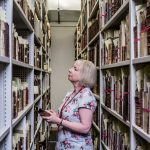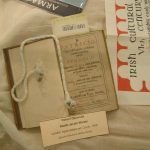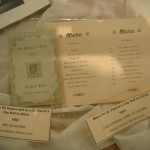Internship at Special Collections
For our latest blog post, we’re handing over the reins to QUB Medieval History MA Student Mark Brink, who spent two months of last Semester working with the team in Special Collections as part of his Public History Internship Module. A native of New Orleans, Mark gained his BA in History from Spring Hill College, Mobile, Alabama. As part of his undergraduate course, Mark opted to study for a brief period of time at Queen’s University Belfast.He clearly enjoyed himself during his study abroad stint, opting to return to Queen’s to take his Masters.
Here, he reflects on his time as an intern in Special Collections:

Mark Brink
“As a part of my coursework for an MA in Medieval History, I was given the option of taking on an internship for seven weeks in which I would learn from experienced professionals working in a pertinent field. After looking at the different options available, I made the choice to spend my seven weeks with the McClay Special Collections and Archives.
On the first day I was given a tour of the facilities. I was shown to my desk where I would be stationed. Then I was given a key card on a lanyard that would allow me to seamlessly pass through any of the more restricted areas. One of these was the book store, which, as the name implies, is where the special collections houses its books. It’s not a massive room, but it is well kept. The room is carefully monitored for temperature to protect its precious contents. Why is everything kept under lock and key in such contained environment? According to the Special Collections library guide:
The books, pamphlets, manuscripts, correspondence, photographs, and maps held in Special Collections are considered to be of lasting research value and include examples of the earliest printed works (incunabula), and books and pamphlets published between the 16th and early 19th centuries (STC and Wing items). In order to preserve the material for future readers these collections are housed in a secure and environmentally controlled setting.
So, while the special collections can seem to be a sequestered, little visited quadrant on the first floor, there is a good reason for it.

I became fairly well acquainted with the book store and came to enjoy the wealth of awfully interesting things through which I could browse whenever I had a bit of free time. Of course, there were also occasions when I needed to fetch books for those waiting eagerly to read them. This was a bit tricky at first due to the slightly more complicated sorting system compared to the stacks in the McClay, but it became easier with a bit of practice. Looking through the old books was quite enjoyable and I would have liked to spend more time roving the cool, temperature controlled volumes at my leisure. However, most of my time was spent outside of the book store working on different projects.

While one of the McClay Special Collections’ main purposes is safeguarding rare, old, and valuable books, manuscripts, etc., there is a great amount of work involved beyond simply keeping the books in order on the shelves and making it marginally more difficult to access research materials. When new items are acquired, it is often up to the staff to write descriptions, catalogue, transcribe, and translate the items more properly so they can be easily accessed and used by students, professors, and the general public.

I spent much of my time working on a set of news clippings which were recently donated by a retired professor. As I was the first person from Special Collections to really delve into these, I was excited by what I could potentially find. All told, there were six main volumes of clippings. Giving them a cursory glance, it wasn’t altogether difficult to figure out their original use. They were clearly marked as “French Literary I-V” and “French Political I” and all of them were already very handily indexed from A to Z with proper corresponding page numbers (for the most part). Based on what I found within the clippings (and with a bit of information from the original donor), it is likely these news clipping collections were meant as class aids or research aids for those studying French at QUB. In order to make these more readily available to those looking for them online, I set out to type out a catalogue for each volume using the already intact indexes as a guide. As of now these catalogues are mostly complete, but I am continuing to work on them a bit more during the coming weeks. In the same vein, I am also working on a RASCAL description for this small collection which would allow researchers to find them via online search.

During the course of the day I would also work on various other projects as others asked for my help or as I wanted a change of pace. I especially enjoyed working on a set of letters of correspondence from the Irish author, Edith Somerville, to the English composer, Ethel Smyth. I was lucky enough to read through and work on letters written during the Irish Civil War while Edith Somerville was living near Cork. Because of this, I was able to read about the events from a very spirited (in more ways than one) first-hand account. While Somerville was a straightforward and unabashedly independent person, she also claimed to convene with the dead throughout the letters I examined. She was especially keen on having séances with Violet Ross, her cousin and co-author on numerous books. It seemed as if she was still using these spiritual meetings to ask for Ross’s advice in the writing of current projects. I was able to help a fellow staff member transcribe a number of these letters and then went on to write descriptions of each letter to aid in any future searches for specific topics in the letters.

On occasion, I would help with the collection of Robert Hart’s diaries and various papers. Hart was a Belfast native and also a key player in trade agreements with China during the late 19th and early 20th centuries. As an exciting aside, his house in Peking (Beijing) was destroyed during the Boxer Rebellion in 1900, but some of the only things saved from the house before its destruction were his personal diaries. They were indeed important to him, but also of great interest to researchers today due to his descriptions of trade agreements, politics at play, social interactions, etc. Unfortunately, Robert Hart also has some of the very worst handwriting I have ever seen, especially in his later volumes, so it was difficult work. I was able to look through a few folders of his loose papers with another student assistant who discovered quite a sizeable collection of Hart’s poems which is a remarkable and valuable find. I was also able to roughly transcribe and translate one of his diary entries which was written in French which incredibly challenging, but still a fun little project.


On another note, Special Collections is in charge of the display cabinet on the first floor. Shortly before St. Patrick’s Day, I had the pleasure of taking a turn to put up a display on St. Patrick which was suited to my academic interests as a medievalist. All in all, I was able to gather up around 20 different books and various items which I thought made a fairly passable and attractive collection. I included some of the more important literature on St. Patrick from John Bury, Mario Esposito, etc., but I did have a hand from a staff member who showed me a few older items such as one printed book from 1659 on the seven champions of Christendom (Patrick being one of them).

I was also shown a book from Somerville & Ross, A Patrick’s Day Hunt, and Robert Hart’s invitation to a St. Patrick’s Day Ball in 1901 which included a 20 course menu. Being so topical and in line with some of the more current interests in the special collections, I was very happy to include these as well.
All in all, I am absolutely interested in a future working with history and my time with the McClay Special Collections has been an excellent and rewarding experience on that path. Truly, Special Collections is a safe repository for the old, rare, and valuable, but it takes a lot more work than it may seem to keep up with the collections, acquire new ones, properly catalogue the acquisitions, and make everything manageable and accessible to those wanting to take a curious look or those who need some of these items for their research. But, in any case, I would not have enjoyed this internship nearly as much if not for the staff. They have been able to help guide me in the projects and answer my constant questions for clarification. Across the board, everyone has been incredibly friendly, welcoming, and helpful and I must thank them for creating such an excellent atmosphere amidst the musty manuscripts and rolling shelves of the McClay Special Collections.”
We’d like to thank Mark for writing this account of his internship at Special Collections. It was a real pleasure to have him working alongside us last semester. All on the team at Special Collections and Archives send him their best wishes as he puts the finishing touches on his MA Dissertation ahead of his graduation at Christmas.


I would be very interested to learn more about the poems of Robert Hart. I know that he wrote his own music compositions and tried to publish them, although I have not been able to find any. I also know he collaborated with Bessie L’Evesque , who was a singer and published several songs. So maybe these poems were for songs?
Hi Keith, many thanks for commenting. So far we haven’t got evidence in the papers themselves of Hart’s poetry – it may be there but we’ve haven’t yet seen it. The papers we have are mainly post 1900, as only the diaries survived the Boxer Uprising. However, if we come across anything we will of course let you know.
It depends when Hart wrote his poems but Alice Chavannes married Émmanuel-Édouard Chavannes (5 October 1865 – 29 January 1918) in 1891 and they stayed in Beijing until 1893. Long after she had left China Hart continued to write to her at least until after 1901. After her husband died she collaborated but the French composer Louis Julien Rousseau ( 1873-1950) and together they published more than 23 albums of songs. An example is :- Chinese fables from the 3rd to the 8th century AD (of Hindu origin) / trad. by Ed. Chavannes; versified by Mrs. Ed. Chavannes, [s.d.] . These seem to have been published in 1909 as “Dance, sing!”. Dansez, chantez ! Chansons et danses mimées par A. Chavannes, musique de L.-J. Rousseau .
Le pinson. – [3] (1909)
La tortue. – [4] (1909)
Jolis ballons !. – [1] (1909)
Le Vent. – [15] (1909)
Mes boeufs. – [2] (1909)
Le poisson. – [10] (1909)
Petit Lapin. – [11] (1909)
La sauterelle. – [7] (1909)
Les Chameaux. – [12] (1909)
La sauterelle. – [7] (1908)
I can only find one copy in the Bnf site. Alice seems to have been a prolific writer and maybe in his Diaries there will be more details, that ‘s if the poems come from the same period.